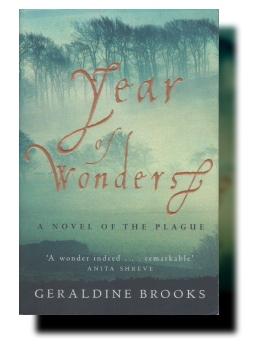 |
Review: Year of Wonders |
   |
Geraldine Brooks, (2002) Year of Wonder: A Novel of the Plague (London: Fourth Estate) ISSN 1-84115-458-X (pb). Written in the first-person, this engrossing fictionalised account of the devastating history of the Eyam Plague explores the impact of the catastrophe through the experiences of the resilient young villager Anna Frith.
Year of Wonders evokes a strong sense of village life before the arrival of the plague and depicts its deadly spread in horribly plausible prose, as the Black Death takes hold and ravages its way through the village decimating whole families. Tragedy is visited upon Anna herself, as her own family – along with friends and neighbours – succumbs to the plague. In her grief, Anna discovers within herself reserves of strength, courage and bravery that have hitherto remained hidden. Having Anna employed at the house of the local rector Monpellion (a character based on, in Brooks' words, 'the heroic and saintly' real-life Eyam rector William Mompesson) allows the author to depict at close hand the decision to isolate the village and to sit out the contagion in the hope of respite. It also allows her to document the developing relationship between Anna and Monpellion's wife Elinor (based on Mompesson's wife Catherine) – whose own acts of bravery and self-sacrifice become a central element of the book. Although the picture that Brooks paints of the 'rural idyll' in which Eyam exists prior to the plague is somewhat over-romanticised (to provide the strongest possible contrast with the bleak misery that follows) this is not a melodramatic tale of flawless heroism. There are numerous examples of the less palatable aspects of the community's behaviour – as the wealthy use their resources to flee before the quarantine takes effect (rejecting rector Monpellion's urging that they stay put as an example to the villagers). Several of the villagers are also shown to be selfish, amoral, self-destructive or prepared to seek personal advantage through the privations of the disaster. Many sequences in the book make for gruesome and unflinchingly realised reading: particularly those in which the community seeks to take vengeance on those of its number judged guilty or complicit in the catastrophe that has befallen them all. Monpellion is shown needing to expend enormous energy to convince his sceptical parishioners of the need to isolate their community; and as their numbers are savagely depleted in the weeks and months that follow his own religious conviction is shown to come under acute strain; as well as his own physical and mental health. A recurrent image in the storyline is the open-air church service, held in a culvert close to the centre of the village. The ceremony provides an effective and chilling means to depict the compound effects of the disease, as the numbers of those attending the service dwindles and the community begins to doubt the wisdom of their self-sacrificial decision. The novel is imbued throughout with rich and evocative imagery – from the atmospheric descriptions of place, landscape, climate and custom; to the shocking onset and development of the cruel and unforgiving disease. There is a tangible, visceral quality to the prose, and a powerfully-evoked sense of the village as an empty, fearful and closed-down place in which the settlement awaits a fate that it feels outside of its control. Despite the occasional narrative contrivance, real effort is made to locate the story in the geography and time of seventeenth century Eyam, and to integrate key elements of the known historical record into the storyline. Brooks also copes well with the question of the 'condescension of history' when demonstrating how little the villagers could possibly have understood the causes of the calamity by which they were confronted. Year of Wonders concludes with the passing of the plague outbreak,
and offers an unexpected (if not entirely convincing) resolution for the
book's central remaining character. Understood as an imaginative reinterpretation
of the real story of the Eyam Plague, and not a simple historical rendition,
Year of Wonders can be appreciated as an absorbing, inspiring
(if often harrowing) read. Brooks' emotional and psychological themes
resonate in the present-day and her imagery lingers in the reader's mind
long after the closing chapter. Mad Dog > Derbyshire's 'plague village' >
Page last updated: |
 As the author Geraldine Brooks makes clear in her 'Afterword', the story intertwines historical fact and dramatic invention, populating the narrative with both actual and fictional characters. The result is a remarkable and engaging study of human tragedy and frailty, and of the self-sacrifice that enables the Eyam survivors to endure the plague's terrible cost.
As the author Geraldine Brooks makes clear in her 'Afterword', the story intertwines historical fact and dramatic invention, populating the narrative with both actual and fictional characters. The result is a remarkable and engaging study of human tragedy and frailty, and of the self-sacrifice that enables the Eyam survivors to endure the plague's terrible cost.